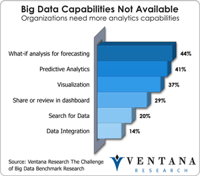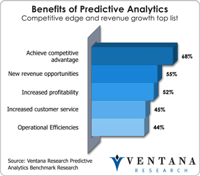In the realm of technology that matters for business and IT, our firm as part of our responsibility continually assesses the latest technology and how it can impact organizations’ efficiency and effectiveness. Our benchmark research in technology innovation found that 87% of participants indicated the importance of increasing the organization’s value through technology innovation. Every year we take our knowledge from research and technology briefings to focus on our Technology Innovation Awards
Read More
Topics:
Big Data,
Datameer,
Mobile,
Sales,
Sales Performance,
Social Media,
Supply Chain Performance,
Sustainability,
Customer,
ESRI,
Globoforce,
GRC,
HCM,
Kronos,
Kyriba,
Location Analytics,
Marketing,
NetBase,
Office of Finance,
Overall Operational Leadership,
Peoplefluent,
Planview,
SQLstream,
VMWare,
VPI,
IT Analytics & Performance,
IT Performance,
Operational Performance,
Analytics,
Business Analytics,
Business Collaboration,
Business Intelligence,
Business Mobility,
Business Performance,
CIO,
Cloud Computing,
Collaboration,
Customer & Contact Center,
Financial Performance,
Governance, Risk & Compliance (GRC),
Hortonworks,
IBM,
Informatica,
Information Applications,
Information Builders,
Information Management,
Information Technology,
KXEN,
Location Intelligence,
Operational Intelligence,
Oracle,
Workforce Performance,
Contact Center,
Datawatch,
Financial Management,
Information Optimization,
Johnson Controls Panoptix,
Roambi,
Service & Supply Chain,
Upstream Works,
Vertex,
Xactly
One of the most important IT trends over the past decade has been the proliferation of ever wider and deeper sets of information sources that businesses use to collect, track and analyze data. While structured numerical data remains the most common category, organizations are also learning to exploit semistructured data (text, for example) as well as more complex data types such as voice and image files. They use these analytics increasingly in every aspect of their business – to assess...
Read More
Topics:
Planning,
Predictive Analytics,
Customer,
Human Capital Management,
Office of Finance,
Budgeting,
close,
closing,
Finance Analytics,
PRO,
Operational Performance,
Analytics,
Business Analytics,
Business Collaboration,
Business Performance,
Cloud Computing,
Financial Performance,
CFO,
Risk,
costing,
FPM,
Profitability
This is the third in a series of blog posts on what CEOs (and for that matter, all senior corporate executives) need to know about IT and its impact on running a business. The first covered the high-level issues. As I noted, it’s not necessary for a CEO to be able to write Java code or master the intricacies of an ERP or sales compensation application. However, CEOs must grasp the basics of IT just as they must understand basic corporate finance, the production process and – at least at a high...
Read More
Topics:
Planning,
Predictive Analytics,
Sales,
Sales Performance,
Customer,
Human Capital Management,
Office of Finance,
Budgeting,
close,
closing,
PRO,
Operational Performance,
Analytics,
Business Analytics,
Business Performance,
Customer & Contact Center,
Financial Performance,
Information Management,
CFO,
CEO,
FPM,
Profitability,
SPM
I recently started a series of blog posts on what CEOs (and for that matter, all senior corporate executives) need to know about IT. The first covered the high-level issues. As I noted there, it’s not necessary for a CEO of a company to be able to write Java code or master the intricacies of an ERP or sales compensation application. However, CEOs must grasp the basics of IT just as they must understand basic corporate finance, the production process and – at least at a high level – the...
Read More
Topics:
Big Data,
Mobile,
SaaS,
Sales Performance,
Social Media,
Supply Chain Performance,
Customer,
ERP,
Operational Performance,
Business Analytics,
Business Collaboration,
Business Performance,
Cloud Computing,
Complex Event Processing,
Customer & Contact Center,
Financial Performance,
In-memory,
Information Management,
Workforce Performance,
CFO,
CEO,
PaaS
On the first morning of the Pitney Bowes (PB) Insights 2012 User Conference in New Orleans I had the opportunity to meet with John O’Hara, president of Pitney Bowes Software, and his management team. Given the staid reputation of the company, I expected to encounter more formal behavior and a highly structured meeting format. Instead I met an engagingly curious and purposeful management team with a fresh perspective and a portfolio of products that puts the company in the middle of the business...
Read More
Topics:
Mobile,
Social Media,
Customer,
Operational Performance,
Analytics,
Business Analytics,
Business Intelligence,
Cloud Computing,
Customer & Contact Center,
Location Intelligence,
InfoMgt; Location











